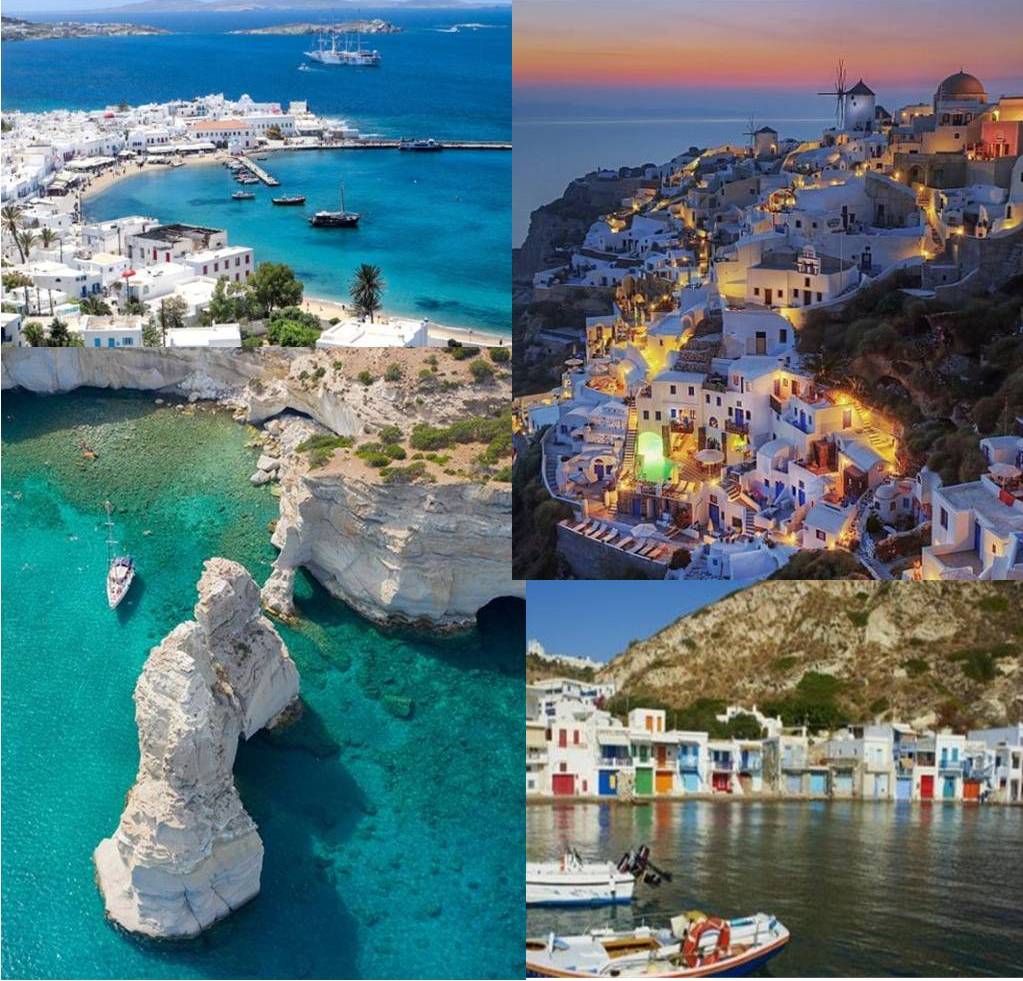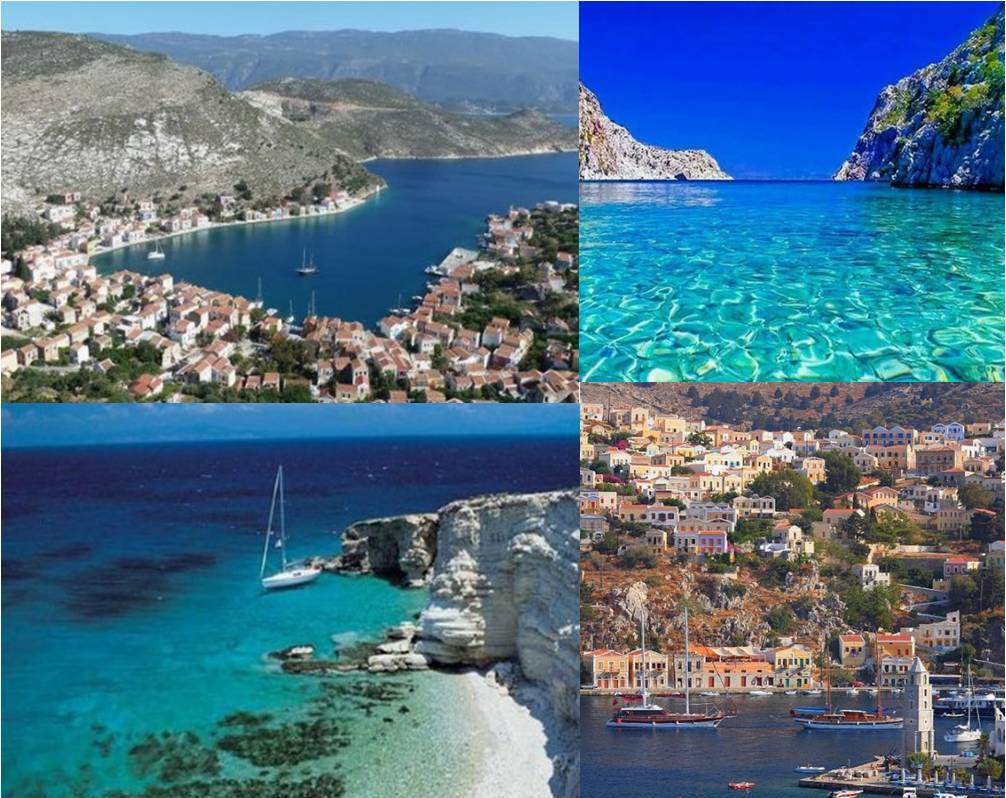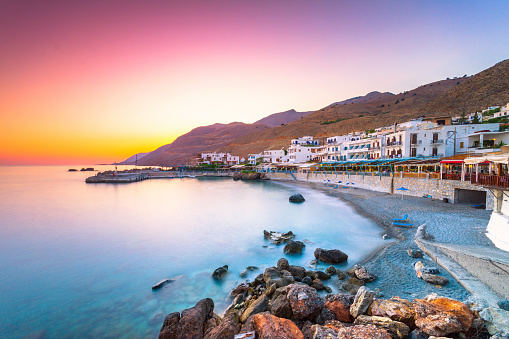All island descriptions taken from Wikipedia.
The Cyclades are an island group in the Aegean Sea, southeast of mainland Greece, in the Aegean archipelago. The name “Cyclades” refers to the islands forming a circle (“circular islands”) around the sacred island of Delos. The largest island of the Cyclades is Naxos. The Cyclades comprise about 220 islands, the major ones being Amorgos, Anafi, Andros, Antiparos, Delos, Ios, Kea, Kimolos, Kythnos, Milos, Mykonos, Naxos, Paros, Folegandros, Serifos, Sifnos, Sikinos, Syros, Tinos, and Thira or Santoríni. There are also many minor islands including Donousa, Eschati, Gyaros, Irakleia, Koufonisia, Makronisos, Rineia, and Schoinousa. Most of the smaller islands are uninhabited.


The Ionian Islands are a group of islands in Greece. They are traditionally called the Heptanese (“Seven Islands”; Ἑπτάνησα, Heptanēsa or Ἑπτάνησος, Heptanēsos; Italian: Eptaneso), but the group includes many smaller islands as well as the seven principal ones.
As a distinct historic region they date to the centuries-long Venetian rule, which preserved them from becoming part of the Ottoman Empire, and created a distinct cultural identity with many Italian influences. The seven islands are; from north to south:
Kerkyra (Κέρκυρα) usually known as Corfu in English and Corfù in Italian
Paxi (Παξοί) also known as Paxos in English
Lefkada (Λευκάδα) also known as Lefkas in English
Ithaki (Ιθάκη) usually known as Ithaca in English
Kefalonia (Κεφαλονιά) often known as Cefalonia, Cephalonia and Kefallinia in English
Zakynthos (Ζάκυνθος) sometimes known as Zante in English and Italian
Kythira (Κύθηρα) usually known as Cythera in English and sometimes known as Cerigo in English and Italian.
The Dodecanese are a group of 15 larger plus 150 smaller Greek islands in the southeastern Aegean Sea, off the coast of Asia Minor (Turkey), of which 26 are inhabited. Τhis island group generally defines the eastern limit of the Sea of Crete. They belong to the wider Southern Sporades island group.
Rhodes has been the area’s dominant island since antiquity. Of the others, Kos and Patmos are historically the more important; the remaining twelve are Agathonisi, Astypalaia, Chalki, Kalymnos, Karpathos, Kasos, Leipsoi, Leros, Nisyros, Symi, Tilos, and Kastellorizo. Other islands in the chain include Alimia, Arkoi, Chalki, Farmakonisi, Gyali, Kinaros, Levitha, Marathos, Nimos, Pserimos, Saria, Strongyli, Syrna and Telendos.


The Saronic Gulf or Gulf of Aegina in Greece is formed between the peninsulas of Attica and Argolis and forms part of the Aegean Sea. It defines the eastern side of the isthmus of Corinth, being the eastern terminus of the Corinth Canal, which cuts across the isthmus. The Saronic Islands in the gulf have played a pivotal role in the history of Greece, with the largest, Salamis, naming a significant naval battle in the Greco-Persian wars. The Megara Gulf makes up the northern end of the Saronic Gulf.
The capital of Greece, Athens, lies on the north coast of the Saronic Gulf. The gulf includes the islands of Aegina, Salamis, and Poros along with smaller islands of Patroklos and Fleves. The port of Piraeus, Athens’ port, lies on the northeastern edge of the gulf. The site of the former Ellinikon International Airport is also in the northeast.
Beaches line much of the gulf coast from Poros to Epidaurus, Galataki to Kineta and from Megara to Eleusis and from Piraeus down to Anavyssos. Athens’ urban area surrounds the northern and the eastern coasts of this gulf.
Bays in the gulf include Phaleron Bay, Elefsina Bay to the north, Kechries Bay in the northwest and Sofiko Bay in the east.
The volcano of Methana is located to the southwest along with Kromyonia at the Isthmus of Corinth, Aegina and Poros. Methana is also the youngest most active volcano center and forms the northwestern end of the cycladic arch of active volcanoes that includes Milos island, Santorini island and Nisyros island. A hydropathic institute at Methana makes use of the hot sulphurous water that still surfaces in the area. The most recent eruption was of a submarine volcano north of Methana in the 17th century.
The gulf has refineries around the northern part of the gulf including east of Corinth and west of Agioi Theodoroi, Eleusis, Aspropyrgos, Skaramangas and Keratsini. These refineries produce most of Greece’s refined petroleum products, a large proportion of which are then exported. Commercial shipping to the refineries, Piraeus, and to and from the canal make the gulf quite a busy area with commercial shipping.
Crete is the largest and most populous of the Greek islands, the 88th largest island in the world and the fifth largest island in the Mediterranean Sea, after Sicily, Sardinia, Cyprus, and Corsica. It bounds the southern border of the Aegean sea.
A large number of islands, islets, and rocks hug the coast of Crete. Many are visited by tourists, some are only visited by archaeologists and biologists. Some are environmentally protected. A small sample of the islands includes:
Gramvousa (Kissamos, Chania) the pirate island opposite the Balo lagoon
Elafonisi (Chania), which commemorates a shipwreck and an Ottoman massacre
Chrysi island (Ierapetra, Lasithi), which hosts the largest natural Lebanon cedar forest in Europe
Paximadia island (Agia Galini, Rethymno) where the god Apollo and the goddess Artemis were born
The Venetian fort and leper colony at Spinalonga opposite the beach and shallow waters of Elounda (Agios Nikolaos, Lasithi)
Dionysades islands which are in an environmentally protected region together the Palm Beach Forest of Vai in the municipality of Sitia, Lasithi
Off the south coast, the island of Gavdos is located 26 nautical miles (48 km) south of Hora Sfakion and is the southernmost point of Europe.


The (Northern) Sporades are an archipelago along the east coast of Greece, northeast of the island of Euboea, in the Aegean Sea. They consist of 24 islands, four of which are permanently inhabited: Alonnisos, Skiathos, Skopelos and Skyros.[1] They may also be referred to as the Thessalian Sporades.
“Sporades” means “those scattered” (compare with “sporadic”). From Classical Antiquity the name has referred to the Aegean island groups outside the central archipelago of the Cyclades. In modern geographical parlance, there are five different Sporades groups:
Thessalian Sporades (Θεσσαλικές Σποράδες) or Northern Sporades. Since c. 1960, the term “Sporades” refers mainly to these islands:
Skopelos, Alonnisos, Skiathos, Skyros, Kyra Panagia, Peristera, Gioura, Skantzoura, Piperi, Tsougria.
| Cookie | Duration | Description |
|---|---|---|
| cookielawinfo-checkbox-analytics | 11 months | This cookie is set by GDPR Cookie Consent plugin. The cookie is used to store the user consent for the cookies in the category "Analytics". |
| cookielawinfo-checkbox-functional | 11 months | The cookie is set by GDPR cookie consent to record the user consent for the cookies in the category "Functional". |
| cookielawinfo-checkbox-necessary | 11 months | This cookie is set by GDPR Cookie Consent plugin. The cookies is used to store the user consent for the cookies in the category "Necessary". |
| cookielawinfo-checkbox-others | 11 months | This cookie is set by GDPR Cookie Consent plugin. The cookie is used to store the user consent for the cookies in the category "Other. |
| cookielawinfo-checkbox-performance | 11 months | This cookie is set by GDPR Cookie Consent plugin. The cookie is used to store the user consent for the cookies in the category "Performance". |
| viewed_cookie_policy | 11 months | The cookie is set by the GDPR Cookie Consent plugin and is used to store whether or not user has consented to the use of cookies. It does not store any personal data. |